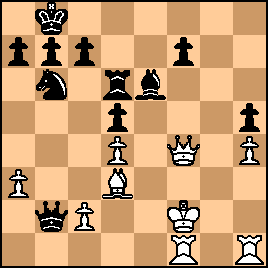| DanLanglois: Garkon! please bring me more nooh gat and bonn bonn while I regale my friends with my bonn mott. 1. e4 e5 2. f4 exf4 3. Nf3 g5 4. h4 g4 5. Ne5 Nf6 6. Nxg4 Nxe4 7. d3 Ng3 8. Bxf4 Qe7+ 9. Be2 Rg8 10. Bxg3 Rxg4 11. Bf2 Rxg2 12. Nc3 d5 13. Qd2 Rxf2 14. Kxf2 Be6 15. Raf1 Nd7 16. a3 O-O-O: 
click for larger viewThis would be thoroughly intriguing, if it was forced. Actually, much of it is forced -- there are pitfalls along the way for White, if he even wants to get this far. Superficially, the position isn't really looking unrealistic for Black in a King's gambit maybe. 17. Ke1 f5 18. Qg5 Qc5 19. Kd1 Qb6 20. Kc1 d4 21. Nb1 forced Bd5 22. Qxf5 forced Bh6 23. Nd2 Bxh1 24. Rxh1 Rf8 25. Qd5 Nf6: 
click for larger viewFine, so maybe this is -+, big deal, one expects that going back over this, we can find improvements for White. One thing all might agree on though -- this position is not what White is hoping for. That this sort of thing isn't viable is something to note. Black is the side with more options here. Let's start over:
1. e4 e5 2. f4 exf4 3. Nf3 g5 4. h4 g4 5. Ne5 Nf6 6. Nxg4 Nxe4 7. d3 Ng3 8. Bxf4 Qe7+ 9. Be2 Rg8 10. Bxg3 Rxg4 11. Bf2 Rxg2 12. Nc3 d5 13. Qd2 Rxf2 14. Kxf2 Be6 15. Raf1 Nd7 and I gave 16. a3. Anything else? Well, 16. Qf4 looks like this: 
click for larger view16...O-O-O 17. Ke1 Nb6 18. d4 Qb4 19. a3 Qxb2 20. Nb5 Bd6 21. Nxd6+ Rxd6 and if we consider 22. Kf2 then 22...Kb8 and shall we say, 23. Bd3 h5: 
click for larger view24. Rfg1 a6 25. Rg5 forced Nc4 26. Rxh5 Nxa3 27. Re5 Nxc2: 
click for larger viewSo that's unhealthy for White.
I'm showing positions where Black has sacked the exchange and White's king is wandering around. How did that come about? Seems like White must have had a choice. The exchange sack is 13...Rxf2. If we walk through this from 5...Nf6 which is book as in the notorious Spassky-Fischer game, then White played 6. d4. I dismiss that as a poor idea, taking 6. Nxg4 as the way to test the line. But, it was good enough for Spassky of course. It is at this point, going forward, where White tends to have few choices. So, if it comes down to the question of 6. d4, that's progress. Eliminating 6. Nxg4 as an option here is a 'stop the presses' thing, because 6. d4 isn't great. Yet it's not really news that 6. Nxg4 has problems -- see opening explorer where these are White's alternatives on the sixth move: 6. Bc4 is 279 games
6. d4 = 117
6. Nxg4 = 32
6. Nc3 = 2
Opening Explorer Strange that I bother even looking at 6. Nxg4, then, but at least I'm not steering anybody wrong in raising suspicions about it. It's apparently not a controversial point at all. Yet this makes for a pretty bizarre little story in King's Gambit theory. We can maybe leave both 6. Nxg4 and 6. d4 on the back-burner, and look at 6. Bc4 first, but it's pretty impressive how bad are the positions that White is accepting in these lines. Why am I not touting the Fischer Defense? Fischer gives 3...d6 4. Bc4 h6 5. d4 g5 as being good for Black, but never considers that White can play 5. h4, preventing 5...g5. So what's plan B? This is actually my specific little problem here with the Fischer Defense. But there seems to be a world of virtue in 3...Nf6, which provokes 4. e5 when Black plays 4...Nh5. This defends the pawn on f4, while speeding Black's opportunity to castle kingside. Might be appealing if Black can castle safely, without having the problem of having played ...g5. Worth a try? | 




